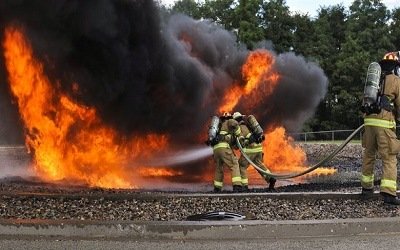Control of Fire and Explosion in Flammable Substances:
Fire or explosion in flammable substance is possible only when it leaks and forms vapour in explosive range. Therefore the first step necessary is to regularly check the tank, container, piping, equipment etc. for leakage and to stop it.
Depending on the vapour density, ventilation should be provided at bottom or upper level to remove accumulation of flammable vapour. If because of heating or cooling the vapour density is changeable, the ventilation/exhaust system should be designed for operating conditions and not for MSDS value.
Natural ventilation opening can be provided near floor, near ceiling or both. Local exhaust ventilation with explosion-proof electrical equipment is the best measure.
Un-burnt gases or flammable vapour in combustion chamber heater, oven, boilers, furnaces may from an explosive mixture. Therefore in the event of flame failure, proper venting or purging time should be allowed or a timed precognition purge cycle should be followed.
A gas detector can be used to check explosive range in the suspected area.
Gas valve and joints should be frequently checked for leaks. If gas is present, ventilation should be allowed before restarting.
Source of ignition is another contributory factor for fire or explosion. Use of flame/smoke detector, flameproof electric equipment, proper earthing to discharge static electricity, checking of spark or heat generating processes and their control, hot work permit etc. are the remedial measures.
Fighting Fire of Pesticides:
 Pesticides when burn emit toxic fumes and when dissolve in fire water, it cannot be allowed to run anywhere as its cannot will become poisonous and birds and animals may die if they drink it. Effect depends upon its toxicity and concentration in air or water. Hazard is also faced by the fire fighters, and the people in vicinity. Therefore utmost care is required while fighting fire of pesticides.
Pesticides when burn emit toxic fumes and when dissolve in fire water, it cannot be allowed to run anywhere as its cannot will become poisonous and birds and animals may die if they drink it. Effect depends upon its toxicity and concentration in air or water. Hazard is also faced by the fire fighters, and the people in vicinity. Therefore utmost care is required while fighting fire of pesticides.
Design of pesticide storage is most important in this regard. Fire detectors and automatic sprinklers should work avoiding human need. Water inside must flow on well designed slope to go to retention basin and from there to the specific collection pond or tank to collect polluted water. Such pond/tank should have proper fencing to keep away people and animal. After the control of fire, this contaminated water must be treated for safe discharge.
If fire takes place in open, persons fighting fire should wear self breathing apparatus, should not face the wind direction, feet, hands and body should be protected, water should be safely diverted to a safe place and covered by sand, lime or any inactivating media. In case of solvent based liquid pesticide, foam and DCP may be more useful.
Other precautions include prohibition of smoking, keeping flammable pesticide away from sun, heat and source of ignition, keeping people away from risk, calling help if needed and cleaning up area and clothing after extinguishing the fire. Medical attention and treatment without loss of time are necessary if any person is adversely affected.
Electrical Fires:
Water cannot be used to extinguish electrical fire till it is energised. If it is possible to put off electrical power supply and to de-energise the electrical circuit, equipment or wire caught in fire, it must be done first. Then this fire can be extinguished as class-A or B, Then water, foam or DCP and CO2 type extinguisher can be used.
If it is not possible to put off electricity (de-energising not possible), it should be treated as class E fire and Carbon dioxide type extinguishers should be used. Sand bucket are also useful.
For a room or enclosure covering electric motors, cable, equipments etc, automatic fire detection and CO2 injection system are available. In electric power plants such systems are more useful to fight electric fires and to save costly machinery.
Rule 66-A (13) (4) of GFR prescribes following statutory provisions where electrical fires are anticipated-
- Where electrical transformers, switchgears motors and electrical apparatus are contained in a room at least two DCP or CO2 extinguishers shall be provided within 15 metre distance from that room.
- In other rooms where motors and other electrical machinery are there, at least one DCP or CO2 extinguisher (Capacity=5 kg) will be provided within 15 metre distance from such room.
- Where electric motors are installed on platform, one DCP or CO2 extinguisher shall be provided for 3 motors on or below the platform.
This is in addition to the general requirements stated in the rule (66-A)
Thus fighting of electrical fires requires special precaution and provision as stated above.
Effects of Combustion Products:
Due to incomplete or complete combustion, following gases are produced and their effects should be controlled as under-
| Combustion products (effects) due to Fire | Control measures required |
| 1. Fire radicals to maintain chain reaction | DCP or CO2 |
| 2.Heat due to exothermic reaction | Water curtain or shield for protection from radiant heat. |
| 3. Water vapour | Allow to escape safely. |
| 4. CO | Proper respirator for this toxic gas. Increase oxidation, CO detector with alarm on furnaces. |
| 5. CO2 | Allow to escape safely. |
| 6. SO2 | Allow to escape safely. Use tall chimney or flare etc. |
| 7. Gases depending on type of burning chemical (Toxic gases from pesticide burning etc.) | Use appropriate respirator or gas mask to fight such fire. |





